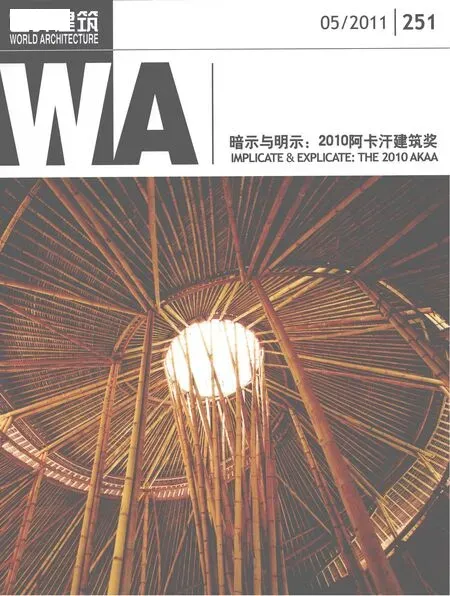中国建筑与阿卡汗建筑奖[1]
2011-04-14法洛克德拉克沙尼FarrokhDerakhshani叶扬TranslatedbyYEYang
法洛克·德拉克沙尼/Farrokh Derakhshani叶扬 译/Translated by YE Yang
school in Burkina Faso designed by local architect Diébédo Francis Kéré to the Grameen Bank Housing Programme in Bangladesh and from Paris' Institut du Monde Arabe, designed by Jean Nouvel, to Ken Yeang's groundbreaking bioclimatic office building in Malaysia and Han Tümertekin's B2 House in Turkey.Other past Award recipients have included Lord Norman Foster, Cesar Pelli and Ricardo Legorreta.
The Award is governed by a Steering Committee chaired by His Highness the Aga Khan. The members of the Steering Committee for the period 2008-2010 are: His Highness the Aga Khan (Chairman),Mohammad al-Asad (Founder & Chairman, Center for the Study of the Built Environment, Jordan),Homi K. Bhabha (Director of the Humanities Center,Harvard University, USA), Norman Foster (Founder and chairman, Foster + Partners, UK), Glenn Lowry(Director, Museum of Modern Art, New York, USA),Rahul Mehrotra (Principal, RMA Architects, India),Mohsen Mostafavi (Dean of the Graduate School of Design, Harvard University, USA), Farshid Moussavi(Partner, Foreign Office Architects, UK), Han Tümertekin (Principal, Mimarlar Tasarim Danismanlik Ltd, Turkey). Farrokh Derakhshani is the Director of the Award.
The Awards are selected by an independent Master Jury appointed by the Steering Committee for each three-year Award cycle. The nine members of the 2010 Master Jury are: Souleymane Bachir Diagne(Professor, Department of Philosophy, Columbia University, USA), Omar Abdulaziz Hallaj (Architect;Chief Executive Officer, Syria Trust for Development,Syria), Salah M. Hassan (Art historian and curator;director of Africana Studies and Research Center,Cornell University, USA), Faryar Javaherian (Architect and curator; co-founder of Gamma Consultants, Iran),Anish Kapoor (Artist, UK), Kongjian Yu (Landscape architect and urbanist; founder and dean of Graduate School of Landscape Architecture, Peking University,China), Jean Nouvel (Architect; founding partner,Ateliers Jean Nouvel, France), Alice Rawsthorn (Design critic, International Herald Tribune, UK), and Basem Al Shihabi (Architect; Managing Partner, Omrania &Associates, Saudi Arabia) . □
三年前,我有幸在清华大学进行了一次有关阿卡汗建筑奖的演讲。现在,有一个中国项目获得了2010年阿卡汗建筑奖,我感到非常高兴。祝贺建筑师李晓东、他的合作者、平和县政府,特别是下石村的居民。
自1977年阿卡汗建筑奖设立以来,阿卡汗殿下和专家委员会就对中国有着强烈的兴趣。1981年,我们与中国建筑学会合作,组织了当时中国最大规模的国际研讨会,大量专家学者从世界各地来到中国探讨农村居住建设问题。此次会议的成果已经结集成书,出版了汉语、英语和法语版本[2]。
我们与中国建筑师的合作延续至今。最近几届阿卡汗建筑奖有数个来自中国的项目参评,本届终于有中国项目获奖,是阿卡汗建筑奖历史上的第一次。
在颁发奖项时,我们铭记在心的是以下3点:首先,要让全世界的建筑师、专家和决策者注意到建筑上具有杰出表现的项目;其次,要突出强调具有社会效益、能够为社会服务的项目,这样,世界上其他地方的人能够从中吸取经验;第三,要明确当今建成环境所面临的重大问题,通过讨论这些议题,我们能更好地了解它们,从而学习如何处理它们。
从这些项目中,我们能学到重要的一课:它们都是参与各方良好的理解与合作的产物。根据每个项目的性质,相关的人员,包括业主、承包商、工程师、工匠、政府与建筑师,组合在了一起。建筑师起到了催化剂的作用,但是其他参与项目的人也对该作品的社会及美学价值有着深远的影响。
我希望大家能够提交更多好的作品,参与到2013年阿卡汗建筑奖的评选之中。□
Three years ago I had the privilege to give a lecture on the Aga Khan Award for Architecture at Tsinghua University. I am so happy that now we have a Chinese project which has received the 2010 Aga Khan Award for Architecture. Congratulations to the architect Li Xiaodong, his collaborators, the local government of Pinghe and especially to the inhabitants of the Xiashi village.
Since the inception of the Aga Khan Award for Architecture in 1977 His highness the Aga Khan and the Award Steering Committee have had a keen interest in China. In 1981, with the collaboration of the Architectural Society of China, we organized the largest international seminar at the time in China,bringing numerous experts from around the world to discuss the Rural Habitat. The proceedings were published in Chinese, English and French[2].
Our collaboration with Chinese architects has continued. Several projects from China were nominated in previous cycles of the award, but this is the first time in the Award history that a Chinese project is amongst the winners.
By giving the Awards, we have three things in mind: first, to bring architecturally exceptional projects to the attention of architects, experts and decision makers around the world; second, to highlight the social benefits of projects that are of service to their communities so lessons can be drawn by people in other parts of the world; third,to identify the important issues that the built environment faces today and by discussing these issues, we come to a better understanding of them and then learn how to tackle them.
One important lesson that could be learnt from all these projects is that they are all results of a good understanding and collaboration between the parties involved. Depending on the nature of each project, the combination of people involved can include the client, the contractors, the engineers,the craftsmen, the authorities and the architect.The architect often plays the role of catalyst, but the other people engaged in a project can also have a profound impact on its value both in social and in aesthetic terms.
I encourage you to submit more good projects to be considered for the 2013 Award Cycle. □
注释/Notes:
[1] 该文节选自法洛克·德拉克沙尼为2011年4月1日在清华大学建筑学院举办的“暗示与明示:2010阿卡汗建筑奖研讨会”所致的欢迎辞/The Welcome Intro by Farrokh Derakhshani for"Implicate & Explicate: a Seminar on the 2010 Aga Khan Award for Architecture" in Tsinghua University, on April 1st, 2011.
[2] 该成果为《变化中的农村居住建筑》第1卷:实例研究及第2卷:背景论文/The Changing Rural Habitat, Volume 1:Case Studies and Volume 2: Background Papers (Seminar VI,Beijing, October 1981, in English, French and Chinese)
